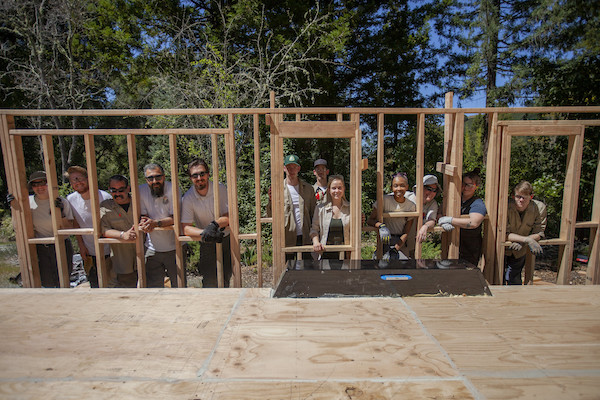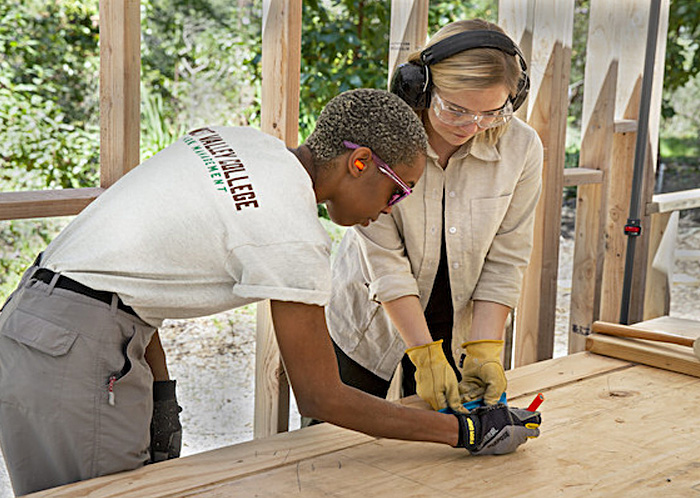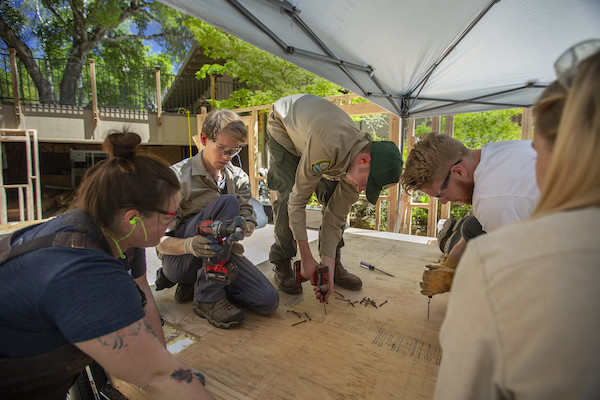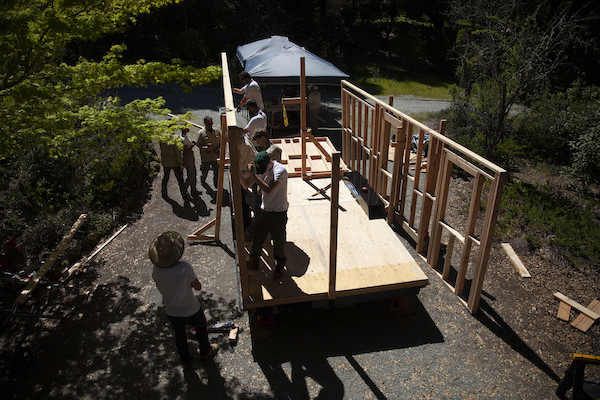West Valley College Tiny House Project
|
|
|
By Margarita Kompelmakher
The tiny house project—a collaboration between the Tiny House Design Build Group, Park Management and Interior Design program—tackles housing problems and teaches students valuable construction skills. It received a Strong Workforce Development Grant from the Center for Workforce Development at West Valley College.
It is the epitome of compact living: a kitchen, bathroom, living/dining area, master bedroom with queen bed, and a separate reading loft, in less than 400 square feet. A collaborative effort is currently underway at West Valley College to build a tiny house that could offer tangible solutions to the pressing issue of affordable housing and homelessness.
The tiny house project was the brainchild of Victoria Schellenberg, a student in the Interior Design Program, who worked with Chris Wright, a faculty advisor from the program, to successfully pitch the idea to construct a tiny house on the West Valley campus.“I fell in love with the idea of tiny houses, and the fact that they are sustainable, affordable, create a mortgage-free living, and are a great way to express individuality,” says Schellenberg.
Tiny houses were part of an economically and ecologically driven subculture since at least the 1980s (with the publication Tiny Houses by Lester Walker in 1987), but have gained more attention since the 2008 recession as a solution to housing problems among community planners and activists. In 2016, San Jose became the first California city to allow tiny houses as part of a long-term effort to relieve homelessness in the Bay Area. The San Jose Conservation Corps has recently started a pilot project to park tiny homes on the property of their charter school to provide housing for students, over 30% of whom are experiencing homelessness.
The ethos behind tiny houses appeals to a younger generation whose core values include sustainability, independence, and individuality. At less than 400 square feet, tiny houses yield a smaller carbon footprint and are not subject to many housing codes that regulate building developments, easing the pathway to housing independence and making the houses far more economical.
Many West Valley students, and others in the Bay Area, are acutely sensitive to the issue of affordable housing as their generation has been more excluded from the housing market than the previous one.
“As an interior designer, I value the comfort and safety a home can offer,” says Schellenberg. “I have a huge heart for those not fortunate enough to have a home. I want to start by tackling homelessness here in the Silicon Valley.”
In Fall 2018, a student-led campus club was formed to realize the tiny house project. Students from the Interior Design Program, as well as from Architecture, Engineering, Business, and the Sciences, joined the club and a design competition was held to choose a plan. The winning design became known as the “Kundig House” for its wall-sized windows, a trademark of the famous architect Thomas Kundig.
Meeting every Monday, students formed three subcommittees to research and develop three aspects of the plan: exterior, interior, and appliances.
The building of the structure was folded into the Park Management course Introduction to Park Maintenance in Spring 2019. Five students from the Tiny House Design Build Group joined seven Park Management students for the construction.
Measure Twice, Cut Once
The road to the first tiny house at West Valley College was not always smooth.
In March, a safety and liability audit of the project raised concerns about the structural design of the Kundig House. The team made the decision to have the plans checked by a structural engineer and architect to make sure it could withstand the shock of traveling by trailer on the freeway and to make it safe for occupancy.
“While some tiny homes are not subject to code, is a whole other story when you are building for somebody else,” says Heidi McFarland, instructor of the Introduction to Park Maintenance course. “It has been an incredible learning opportunity for all of us, not just the students and myself, but even the college administrators, in terms of what it takes to build a solution for the homeless and the importance of following building codes, no matter how ‘tiny’ the construction.”
The review meant a substantial delay in building the Kundig House and an emergency session with students, faculty, and administration was called to figure out what to do in the meantime. “The moment of truth was when we had to make a decision to build another set of plans,” says McFarland.
“Since we had a trailer, we wanted to put it to good use and have a first go of building a tiny house from a commercial model,” says Schellenberg. “We purchased plans from our trailer supplier and are now building our first tiny house. It is called the Tiny Living model and it is a 20 ft long trailer that is 8 ½ ft wide. That is what we are constructing every Tuesday.”
On April 23rd the Intro to Park Maintenance class put up the walls of the Tiny Living house.
“This project is going to give them confidence in their ability to construct something,” says McFarland, who oversees the construction with assistant instructor David Aguirre and three advanced students from the Park Management program. “They are learning framing, electrical, and plumbing. They are also learning basic carpentry skills and project planning overall.”
These hands-on construction skills are a major reason that the Dean of Workforce Development, Brad Weisberg, funded the tiny house project. “I know that the construction and trades industry is a huge employer in the Silicon Valley,” says Weisberg. “Part of the housing shortage is due to the fact that they cannot find enough construction teams to do these projects.”
“If I can dream, this tiny house will lead to another tiny house and another. Before we know it we would be teaching students how to build to code. Skills that can lead to employment,” adds Weisberg.
“I think that it has brought everybody involved closer together and now contributes to an increased level of communication,” says Jamie Jang, an architecture student who designed the winning tiny Kundig home. “We're trailblazing something entirely new at West Valley College, so there will certainly be hiccups. What is important is how we react.”
A modified version of Jang’s Kundig home is scheduled to be built in Fall 2019, pending approval from the review process.
|
|
|
Thinking Outside the (Tiny House) Box
The tiny house project is an opportunity to engage the campus in a discussion about what makes us feel safe and happy, and how we might create alternative solutions to shared spaces for our communities. What can you live without? What is essential to your well-being?
“Interior design is often thought of as a luxury business,” says Schellenberg, who also works with the San Jose Conservation Corps designing tiny houses for their housing solutions project. “Tiny Houses offer the chance to provide good design on a smaller scale. I believe everyone deserves good design.”
“This project will not end with one tiny house being built in the fall. We already have plans in process to hold another design competition, and this time on a much larger scale,” says Schellenberg. “We hope to have a campus-wide competition where everyone can vote (for the best design) before Thanksgiving.”
Information days for the Fall 2019 Design Competition are tentatively scheduled for May 13th, September 9th, and October 1st from 2-3pm in the Campus Center Global Room. Those interested in participating in the Tiny House Design Build Group are welcome to attend the weekly Monday meeting from 3:30-4:30pm in the Campus Center Global Room.
In the short term, the Tiny Living house currently under construction will be displayed on campus, just in time for the Park Management program's 50th Anniversary in 2020. No one will occupy the house until it is inspected and cleared for occupancy by the appropriate authorities.
Students interested in building a tiny house next semester can join the Intro to Park Maintenance PM15C course (prerequisite is required, but can be waived by Park Management Department chair, Chris Cruz).
“There are so many opportunities at West Valley, this school is so innovative and so excited about students trying new things,” adds Schellenberg.
May 3, 2019




